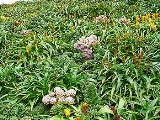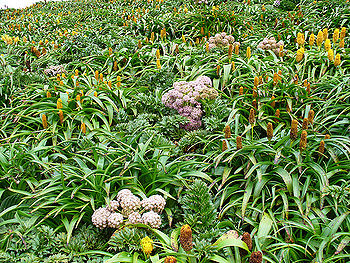
Megaherb
Encyclopedia

Herbaceous
A herbaceous plant is a plant that has leaves and stems that die down at the end of the growing season to the soil level. They have no persistent woody stem above ground...
perennial
Perennial plant
A perennial plant or simply perennial is a plant that lives for more than two years. The term is often used to differentiate a plant from shorter lived annuals and biennials. The term is sometimes misused by commercial gardeners or horticulturalists to describe only herbaceous perennials...
wildflower
Wildflower
A wildflower is a flower that grows wild, meaning it was not intentionally seeded or planted. Yet "wildflower" meadows of a few mixed species are sold in seed packets. The term "wildflower" has been made vague by commercial seedsmen who are interested in selling more flowers or seeds more...
s growing in the New Zealand sub-antarctic islands
New Zealand sub-antarctic islands
The five southernmost groups of the New Zealand Outlying Islands form the New Zealand Sub-Antarctic islands. These islands are collectively designated as an UNESCO World Heritage Site....
. They are characterised by their great size, with huge leaves and very large and often unusually-coloured flowers, which have evolved as an adaptation to the harsh weather conditions on the islands. Livestock introduced to the islands in the 19th century severely reduced the megaherb population, to such an extent that by the late 20th century the megaherbs were threatened with extinction
Extinction
In biology and ecology, extinction is the end of an organism or of a group of organisms , normally a species. The moment of extinction is generally considered to be the death of the last individual of the species, although the capacity to breed and recover may have been lost before this point...
. Since the removal of the livestock in 1993, the megaherbs have regenerated successfully and dramatically. They have been described as "the outstanding botanical experience of New Zealand".
Distribution and history
Megaherbs occur on many of the sub-Antarctic islands of New Zealand, predominantly on the SnaresThe Snares
Snares Islands/Tini Heke is a small island group situated approximately 200 kilometres south of New Zealand's South Island and to the south-south-west of Stewart Island/Rakiura. The Snares consist of the main island North East Island and the smaller Broughton Island as well as the somewhat...
island group, the Auckland Islands
Auckland Islands
The Auckland Islands are an archipelago of the New Zealand Sub-Antarctic Islands and include Auckland Island, Adams Island, Enderby Island, Disappointment Island, Ewing Island, Rose Island, Dundas Island and Green Island, with a combined area of...
and the Campbell Island group
Campbell Island group
The Campbell Island group is a group of subantarctic islands, belonging to New Zealand. The group has a total area of , consisting of one big island, Campbell Island , and several small islets, notably Dent Island , Isle de Jeanette Marie , Jacquemart Island , and Monowai Island 1...
. Here these extraordinary plants evolved in response to the climatological and soil conditions and the lack of herbivorous predators on the islands. The weather is largely wet, cold and extremely windy; the soil peaty, acidic and impoverished. The almost continual cloud-cover means that the islands experience low light levels.
The term 'megaherb' was first used by Sir James Clark Ross
James Clark Ross
Sir James Clark Ross , was a British naval officer and explorer. He explored the Arctic with his uncle Sir John Ross and Sir William Parry, and later led his own expedition to Antarctica.-Arctic explorer:...
during his 1839 – 1843 Antarctic expedition. Sir Joseph Hooker
Joseph Dalton Hooker
Sir Joseph Dalton Hooker OM, GCSI, CB, MD, FRS was one of the greatest British botanists and explorers of the 19th century. Hooker was a founder of geographical botany, and Charles Darwin's closest friend...
, the expedition’s botanist, wrote that the megaherbs produced "a floral display second to none outside the tropics". Although small in size when compared to plants found in the tropics, megaherbs are notable because their size is far greater than other herbaceous perennials found growing in the sub-Antarctic islands: generally the harsh weather and soil conditions experienced there have a stunting effect on plants.
Megaherb species
Most sub-Antarctic megaherbs flower en masse in a cycle of approximately three years; in "off" years a few plants will flower but with nowhere near the effect created by the mass flowering. A visitor in December 1996 (Derek Fell) described a megaherb meadow on Campbell Island: 'We stood in disbelief ... a stupendous carpet of flowers stretched as far as the eye could see'. The following plants are some of the more prevalent megaherb species.A major component of megaherb communities is Bulbinella rossii
Bulbinella rossii
Bulbinella rossii, commonly known as the Ross Lily, is a species of flowering plant in genus Bulbinella. It is one of the subantarctic megaherbs...
(Ross Lily). This clump-forming plant has strap-like and succulent leaves, growing to 60 cm. The bright yellow flowering spikes are carried on up to 90 cm high stems. Its nearest relatives appear to be Bulbinella hookeri (Maori Lily) from the New Zealand mainland, and Bulbinella floribunda (Yellow Cat-tail) from South Africa.
Anisotome latifolia
Anisotome latifolia
Anisotome latifolia, commonly known as the Campbell Island Carrot, is a species of flowering plant in the umbellifer family.-Description:...
(Campbell Island Carrot) bears pink flowers in huge clusters which can reach 75 cm across, on stems up to 1.5 m.
Pleurophyllum speciosum
Pleurophyllum speciosum
Pleurophyllum speciosum, also known as the Campbell Island Daisy, is a megaherb native to the Auckland and Campbell Islands of New Zealand....
(Campbell Island Daisy) appears to be closest related to the Cineraria daisies of Africa and the Canary Islands than any others. It forms an enormous rosette, up to 1.2 m across, of huge, broad pleated leaves. It bears pinkish-purple to pale lilac flowers with maroon centres, held on flower stems up to 60 cm tall.
Two other Pleurophyllum species, Pleurophyllum hookeri
Pleurophyllum hookeri
Pleurophyllum hookeri, also known as the Silver-leaf Daisy or Sage-green Rosette Herb, is a herbaceous plant in the daisy family, a megaherb native to the subantarctic Auckland and Campbell Islands of New Zealand and Australia’s Macquarie Island...
and Pleurophyllum criniferum
Pleurophyllum criniferum
Pleurophyllum criniferum is a species of flowering plant in the daisy family that is endemic to the subantarctic islands of New Zealand.-Description:Pleurophyllum criniferum is a large perennial herb, growing up to 2 m in height...
(giant button daisies) are also megaherbs, reaching 90 cm in height and with similar broad leaves. The flowers of P. hookeri are crimson whilst those of P. criniferum are near-black.
Natural hybrids between these species have been recorded.
The Black-eyed Daisy Damnamenia vernicosa
Damnamenia vernicosa
Damnamenia vernicosa, also known as the Black-eyed Daisy, is a species of flowering plant in a monotypic genus in the daisy family. Its closest relatives are in the genus Celmisia.-Description:...
bears white flowers that are 5 cm wide, although the plant itself grows only to 10 cm high.
Stilbocarpa polaris
Stilbocarpa polaris
Stilbocarpa polaris, commonly known as the Macquarie Island Cabbage, is a species of flowering plant usually placed in the family Araliaceae. It is a megaherb, growing up to about a metre in height, native to the subantarctic islands of New Zealand and to Australia’s Macquarie Island. It was used...
(Macquarie Island Cabbage) is a member of the Aralia family. It grows in clumps to 90 cm tall with fluted, rhubarb-like leaves and lime green flower clusters up to 60 cm wide.
Companion plants in megaherb communities
Growing alongside the megaherbs are other plants, such as hebes, daisies, amber sedge, and three species of gentian: Gentianella cerina (giant gentian), growing to 15 cm tall with flowers 2.5 cm across, varying in colour from white to pale pink, red and purple; Gentianella antarctica and Gentianella concinna, both with pinkish red flowers.Threat to megaherbs
The New Zealand sub-Antarctic islands are uninhabited by humans (apart from scientific research staff at a meteorological station on Campbell IslandCampbell Island, New Zealand
Campbell Island is a remote, subantarctic island of New Zealand and the main island of the Campbell Island group. It covers of the group's , and is surrounded by numerous stacks, rocks and islets like Dent Island, Folly Island , Isle de Jeanette Marie, and Jacquemart Island, the latter being the...
). In the nineteenth century, foraging livestock including rabbits, pigs, sheep, goats and cattle were introduced in order to provide support for potential shipwreck victims.
The feral livestock populations increased to such an extent that their grazing seriously depleted the megaherbs. The New Zealand Department of Conservation
New Zealand Department of Conservation
The Department of Conservation , commonly known by its acronym, "DOC", is the state sector organisation which deals with the conservation of New Zealand’s natural and historic heritage...
began removing all introduced species in 1987; this was completed by 1993. The speed and extent of the regeneration witnessed in 1996, a mere three years later, astonished visiting botanists.
The collection of megaherbs is prohibited. It has been noted that specimens of legally-collected megaherbs growing in botanic gardens at Invercargill
Invercargill
Invercargill is the southernmost and westernmost city in New Zealand, and one of the southernmost cities in the world. It is the commercial centre of the Southland region. It lies in the heart of the wide expanse of the Southland Plains on the Oreti or New River some 18 km north of Bluff,...
in New Zealand's South Island
South Island
The South Island is the larger of the two major islands of New Zealand, the other being the more populous North Island. It is bordered to the north by Cook Strait, to the west by the Tasman Sea, to the south and east by the Pacific Ocean...
seem sickly and puny compared to the wild populations. Megaherbs have evolved to grow in the very specific set of weather and soil conditions experienced on the sub-Antarctic islands, and so fail to thrive in seemingly more benign conditions.
Sources
- Fell, Derek, (May 1998) "Megaherbs of the far south" The Garden (Journal of the Royal Horticultural SocietyRoyal Horticultural SocietyThe Royal Horticultural Society was founded in 1804 in London, England as the Horticultural Society of London, and gained its present name in a Royal Charter granted in 1861 by Prince Albert...
) 123(5):326-329 - Hooker, J. D. (1844) The Botany of the Antarctic Voyage of H.M. Discovery Ships Erebus and Terror in the Years 1839-1843, Under the Command of Captain Sir James Clark Ross; Volume 1: Flora Antarctica; Pt. 1: Botany of Lord Auckland’s Group and Campbell’s Island. Reeve, London
- Mitchell, A. D., Meurk, C. D. and Wagstaff, S. J. (1999) "Evolution of Stilbocarpa, a megaherb from New Zealand's sub-Antarctic islands" New Zealand Journal of Botany 37:205-211 (online at https://www.rsnz.org/publish/nzjb/1999/22.pdf)
- Nicholls, V. J. and Rapson, G. L., (1999) "Biomass allocation in subantarctic megaherbs, Pleurophyllum speciosum (Asteraceae) and Anisotome latifolia (Apiaceae) New Zealand Journal of Ecology 23(1):87-93 (online at http://www.nzes.org.nz/nzje/free_issues/NZJEcol23_1_87.pdf)
- Smith, Philip, (November 2006) "Islands of Diversity" The Garden (Journal of the Royal Horticultural Society) 131(11):756-757
External links
- Joseph Dalton Hooker and megaherbs
- Article on a recent botanic expedition to Campbell Island to view megaherbs
- Photograph of megaherb community on Enderby Island, one of the Auckland Islands
- Another megaherb photograph, Enderby Island
- Another megaherb photograph, Campbell Island
- Another megaherb photograph, Campbell Island
- Megaherb photoset on Flickr

